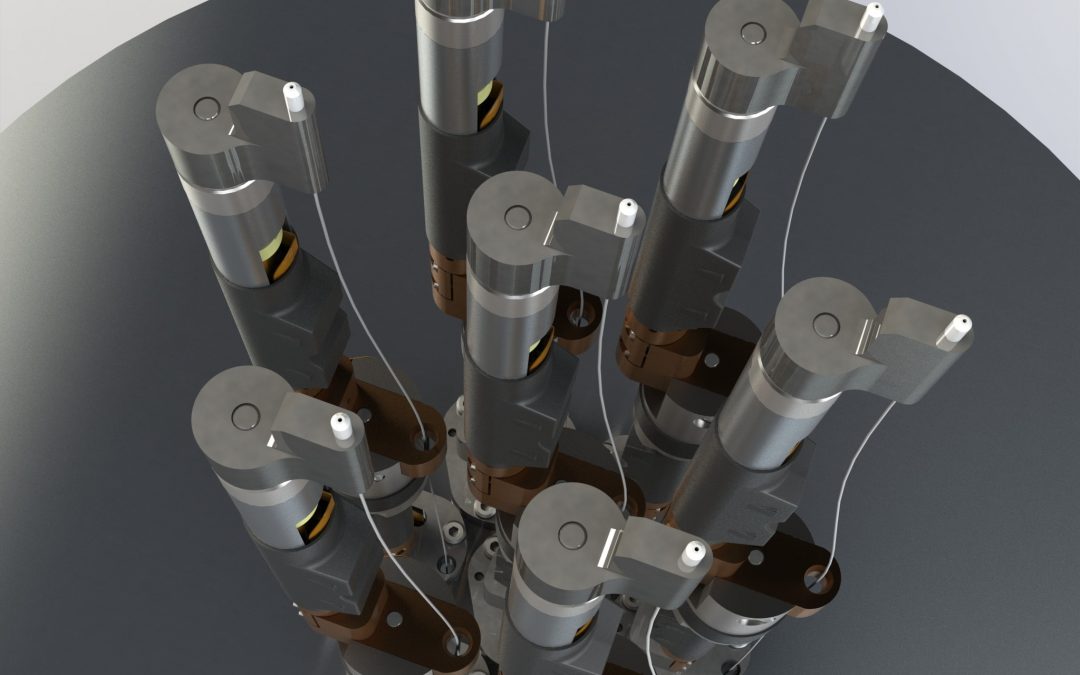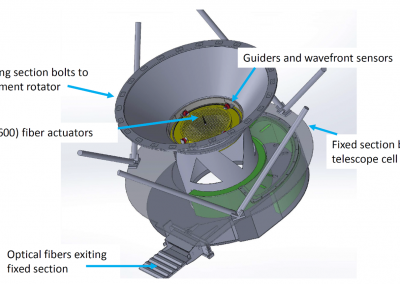New Scale Technologies, a leading manufacturer of the smallest micro positioning systems, is manufacturing prototype Viper fiber positioners for the Via Project. Via is a collaboration between Carnegie Observatories, the Center for Astrophysics | Harvard & Smithsonian, and Stanford University. Via will conduct an all-sky survey of stars using the 6.5-meter MMT (Arizona) and Magellan (Chile) telescopes.
Compared to previous fiber positioners, Viper systems are next-generation robots that provide improved accuracy, simplified integration, faster star-to-fiber alignment, and accelerated data collection. See below for background on New Scale’s Cobra Fiber Positioner used on the Subaru Prime Focus Spectrograph (PFS) delivered in 2017.
Improved Accuracy: Viper robots provide two-axis (Theta-Phi) rotation of each fiber. Embedded absolute angle sensors, on each axis, enable closed-loop positioning for the Viper patrol radius. Direct-drive piezoelectric SQUIGGLE® motors provide high torque with no gears, zero backlash and zero-power hold.
Simplified Integration: The drive and control electronics are mated to each Viper positioner and co-located inside the patrol radius. Each Viper system is factory-calibrated, and the values stored locally. 600 Viper robots are operated from a common EtherCat digital bus and DC power. Via system assembly, integration and testing are accelerated.
Accelerated Data Collection: Local closed-loop positioning speeds fiber-to-star alignment with reduced need for a global fiducial camera. Less time is used for alignment and more time is available for light collection and analysis.
“This new Viper positioner reflects the best capabilities of our mechatronic technologies and team”, stated David Henderson, Founder and CEO at New Scale. “We are combining our newest generation of motors, sensors, electronics and software to achieve the most demanding science objectives of the Via Project”.
“The absolute positioning accuracy provided by the Viper robots will enable much simpler and faster survey operations, which is an exciting possibility for us” says Charlie Conroy, Via Project Co-PI and Professor of Astronomy at Harvard University.
Viper Fiber Positioner Specification Summary
| Parameter | Value |
|---|---|
|
Configuration Type |
Stacked, Theta-Phi |
|
Motors |
Piezoelectric, squiggle® |
|
Absolute Angle Sensors |
13 bits/0.044 deg/0.77 mrad |
|
Robot Spacing (Center-to-Center) |
23.5 mm |
|
Theta and Phi Arm Lengths |
7.64 mm |
|
Fiber Patrol Radius |
15.28 mm |
|
Target fiber position error. |
16.7μm = 0.1 arcsecond |
|
Scale at telescope focus |
~167μm per arcsecond |
|
Focal Plane Integration |
600 robots position 600 fibers |
|
Robot Integration |
Embedded drive and control electronics with factory calibration. EtherCat digital networking and 12-volt DC power. |
About Via Project https://via-project.org/
The Via Project is using the Milky Way galaxy as a laboratory to answer fundamental questions about the nature of the universe. Via will conduct an all-sky survey of stars using the 6.5-meter MMT (Arizona) and Magellan (Chile) telescopes. The survey will utilize the ViaSpec instruments, which will be built and deployed on each of the telescopes.
The ViaSpec instrument collects light simultaneously from up to 600 individual targets using optical fibers to direct the light to the spectrograph. The spectra are used to determine radial velocities with 100 meter/sec resolution for millions of stars. Each fiber is moved to unique star locations using robotic positioners. This configuration allows nearly simultaneous positioning of all fibers and features high fault tolerance. Optical fibers will travel on the neutral axis of a controlled-radius cable carrier in the fiber derotator, and between the fiber positioner and the bench spectrograph. The project is a collaboration between Carnegie Observatories, the Center for Astrophysics | Harvard & Smithsonian, and Stanford University. The survey is expected to start in early 2027 to immediately build on the enabling data released by Gaia DR4 and LSST.
About New Scale Technologies www.newscaletech.com
New Scale Technologies is a leader in micro motion and automation systems that accelerate customer success by advancing scientific discovery, human health, defense and security, product commercialization, and manufacturing productivity. We are uniquely qualified to deliver small, precise, and smart motion modules that embed drive, control, and digital communications inside.
Our customers benefit from dramatically simplified integration, enhanced performance, and accelerated deployment, especially for OEM products, robotic automation, IoT and I4.0 applications. Our products are used by organizations that make DNA sequencers, advanced cameras, photonics and astrophysics instruments, unmanned aerial vehicles, neural recording measurements, and automated metrology tools.
Our skilled staff has decades of experience inventing and producing micro mechatronic systems that integrate precision mechanisms, microelectronics, and plug-and-play software.
New Scale Technologies uses ISO 9001:2015 and ISO 13485:2016 certified quality management systems for the design and manufacturing of its products.
Related New Scale Program
From 2015 to 2017 New Scale supplied Cobra fiber positioners for the Subaru Prime Focus Spectrograph (PFS). The PFS is a fiber fed multi-object spectrometer for the Subaru Telescope that will conduct a variety of targeted surveys for studies of dark energy, galaxy evolution, and galactic archaeology. The key to the instrument is a high-density array of fiber positioners placed at the prime focus of the Subaru Telescope. The system, nicknamed the “Cobra” fiber positioner, is capable of rapidly reconfiguring the array of 2,394 optical fibers to the image positions of astronomical targets in the focal plane with high accuracy. The system uses 2,394 individual “SCARA robot” mechanisms that are 7.7mm in diameter and use two custom rotary piezoelectric motors, developed by New Scale Technologies, to individually position each of the optical fibers within its patrol region.




